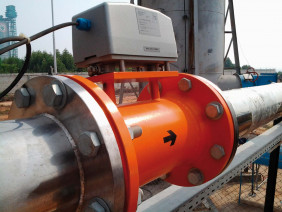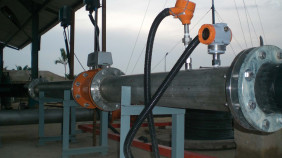Biogas flow measurement

Task
Biogas usually refers to gas generated from organic substance in the absence of oxygen. The source of this kind of bio-fuel is organic waste which can be found in many forms including animal waste, human waste, dead plant and other decaying organic matter. As with any other fuel gas, biogas mainly contains Methane (CH4) and Carbon Dioxide (CO2). It is not that hard to understand that harvesting biogas from waste has two advantages, the fi rst one of course you get ‘free’ energy while at the same time you play your part in keeping the earth greener by reducing the amount of greenhouse gases released to the atmosphere. Looking at the economical potentiality, companies who own palm plantations are nowadays starting to build and operate their own biogas plants, utilizing vast amount of organic waste from the plantation they run.
One thing you always need to do when running a plant is to make sure that your plant is running efficiently. The simplest or most straight forward way to achieve this objective is to measure the output of your plant, in this case, the volume of biogas generated. Measuring the total amount of biogas generated in a biogas plant can be tricky, because you have to deal with a low operating pressure which can be as low as 100 mBar (even at a point downstream of a blower) while on the other hand you have to also consider that biogas is a dirty, humid gas and has the potential to corrode the metal part of the flow meter. And to make it more interesting, biogas is flammable, of course. So, hazardous area certification is a must.
As with any other gas, biogas is compressible, which means that its density varies greatly when there is a change in operational pressure and/or operational temperature. Therefore the operational pressure and temperature must be evaluated to ensure an accurate flow measurement.
Solution
KOBOLD DOG Oscillation Type - Gas Flow Meter. Thanks to the ‘oscillation’ working principle and generously dimensioned flow measuring channels, this unit is extremely dirt resistance and has a self-cleaning effect, which is crucial for a dirty fluid like biogas. Also as this flow meter has no rotating parts, the pressure drop can kept to a minimum. One can expect a maximum 50 mbar pressure drop at Qmax when the DOG measures gas with the same density as air.
And it comes with ATEX II 1G EEx ia IIC T4 approval for hazardous area application.
Other features included in the installed DOG flow meter are anti-corrosion paint and a suitable stainless steel meter run, in order for you to get a good measurement result. Plus, to include process pressure and temperature variables into the calculation, we installed a PAS Pressure Transmitter and a TWL Temperature Transmitter whose outputs were connected to an external Flow Computer, along with the value received from the flowmeter. The output we got derive from the above installation package is the corrected value of biogas volumetric fl ow both in flow rate value (Nm3/h) and total flow value (Nm3).






